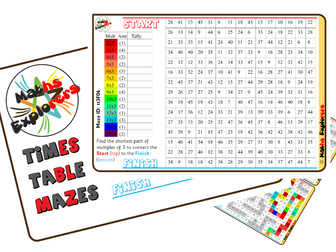Times Tables - Practise Multiples with Mazes
<p>Multiples Mazes help children to get to think about and learn their times tables and get to know the numbers in them. Hidden in a grid of random numbers are paths of multiples of one particular times tables. One of those paths leads from the start (the top of the maze) to the end.<br />
This pack features a maze for each of the times tables from 2 - 9 along with a solution for each maze that highlights all of the paths.<br />
To help students determine if they are on the right track is a tally chart that shows how often different multiples appear in the shortest path from start to finish. Each times table has multiples from 2 x the number to 13, 14 or 15.<br />
These can be used when learning times tables, learning divisibility rules or just as a fun activity to help children consolidate what they’ve learned previously.<br />
This resource comes as a printable pdf and has video guidance to help students get started.</p>

